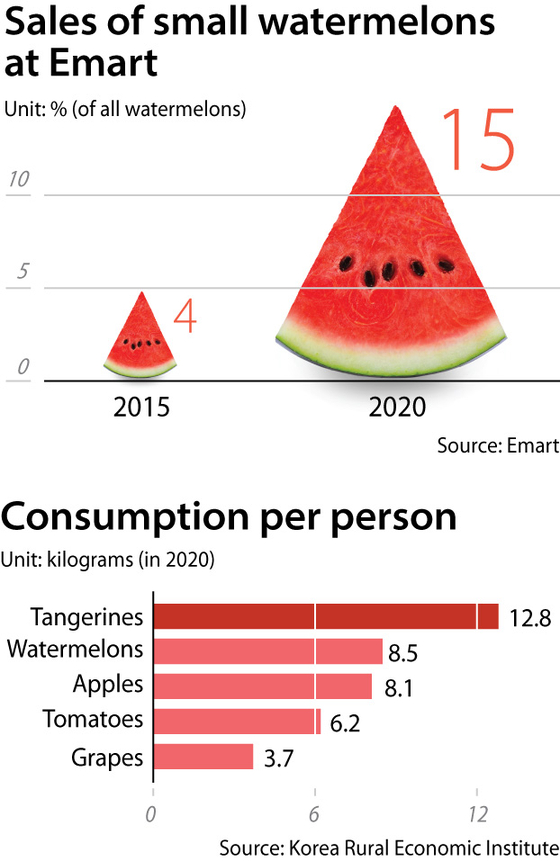Don't panic! Watermelons are smaller for a good reason.
![A visitor shops for watermelons at Lotte Mart’s Seoul Station branch in central Seoul. [LOTTE MART]](https://koreajoongangdaily.joins.com/data/photo/2021/06/12/be8f8671-6df0-4f47-ada4-da88bb055002.jpg)
A visitor shops for watermelons at Lotte Mart’s Seoul Station branch in central Seoul. [LOTTE MART]
“Watermelons are getting smaller,” the 40-something housewife exclaimed. “When I was young, my mom used to buy watermelons that were as big as her head.”
Watermelons are favored by Koreans during the summer season, especially between May and August. On average, each Korean ate 8.5 kilograms (18.7 pounds) of watermelons last year, according to the Korea Rural Economic Institute, making it the second most popular fruit.
Tangerines were No. 1, with the average Korean consuming 12.8 kilograms in 2020.
In Korea, watermelons normally weigh seven kilograms to eight kilograms. But smaller watermelons are gaining popularity in recent years, like those weighing five kilograms to six kilograms, or even three-kilogram watermelons.
Black diamond watermelons that weigh six to seven kilograms, black mango watermelons that weigh two to three kilograms and apple watermelons less than one kilogram are especially in demand.
Back diamond watermelons have a black rind and have fewer seeds than normal watermelons. Black mango watermelons have a black rind and yellow flesh with high sugar content, while apple watermelons have very thin rind so that people can actually pare them like apples.

At Lotte Mart, sales of small-sized watermelons that weigh less than three kilograms accounted for 7.6 percent of total watermelon sales in 2020 from 4.4 percent the previous year.
Sales of watermelon slices was about 30 percent of watermelon sales last year.
The increasing number of single-person or two-person households are a driving force behind the huge popularity of small watermelons.
“As single-person or two-person households are becoming more common in Korea, smaller watermelons are getting attention of customers,” said a spokesperson for Emart.
There were a total of 9.06 million single-person households in Korea in 2020, up 6.77 percent on year, according to data from the Ministry of the Interior and Safety.
About 62.6 percent of all households in Korea were single-person or two-person households as of end of 2020.
“In the past, big-sized watermelons weighing eight to 10 kilograms were popular as family members used to gather all together to share them,” said Shin Han-sol, a watermelon buyer at Lotte Mart. “But these days, consumers no longer prefer big watermelons.”
Garak Market, a wholesale agricultural products market in Garak-dong, southern Seoul, sold 300 tons of small watermelons weighing less than five kilograms last year, compared to 2014’s 50 tons.
“Small watermelons started to appear three or four years ago,” Shin said.
Retailers are scrambling to increase their watermelon inventory.
Emart, which sold more than 60,000 apple watermelons last year, expects to sell 250,000 this year.
![An employee displays apple watermelons at Emart’s Seongsu branch in eastern Seoul. [EMART]](https://koreajoongangdaily.joins.com/data/photo/2021/06/12/9f794662-0413-44fd-952c-8aeb9ec860c4.jpg)
An employee displays apple watermelons at Emart’s Seongsu branch in eastern Seoul. [EMART]
Lotte Mart has opened a separate section in its stores across the country that display various types of watermelons, including black diamond watermelons and apple watermelons.
Black diamond watermelons are especially popular at Lotte Mart, with May’s sales increasing 50 percent compared to same period a year ago, the retailer said.
Homeplus is targeting customers with watermelons that have a high sugar content.
“We’ve only been selling watermelons that have high sugar content,” said a spokesperson for Homeplus. “We choose watermelons that were planted with special methods so that they taste sweeter than others.”
BY BAEK MIN-JEONG, CHEA SARAH [chea.sarah@joongang.co.kr]










with the Korea JoongAng Daily
To write comments, please log in to one of the accounts.
Standards Board Policy (0/250자)